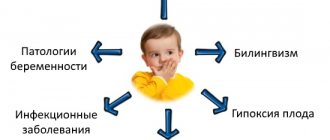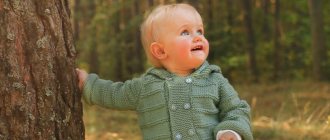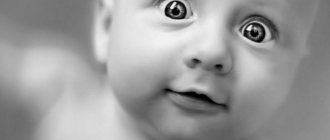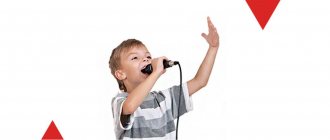Conditions for the formation of pronunciation speech in children are normal
Irina Sinyukova
Conditions for the formation of pronunciation speech in children are normal
Formation of pronunciation speech in children is a very important task for parents and teachers. For full speech development, in particular, for the development of pronunciation skills , the child must be mentally and somatically healthy, have a healthy nervous system and brain. For the pronunciation aspect of speech, the most significant are: normal mental abilities, good vision, good hearing, well-developed breathing, a complete anatomical structure and functioning organs of the nasal and oral cavities without pathology.
In the occurrence of speech disorders, a large role belongs to various adverse effects on the child’s central nervous system and on his body as a whole (infections, injuries, intoxications, toxicosis, obstetric manipulations, etc.). As practice shows, any general or neuropsychic illness of a child in the first years of life is usually accompanied by a violation of speech development. Speech disorders often occur due to various mental traumas (fear, worries due to separation from loved ones, scandals and conflicts between adults, beatings, excessively strict punishments, etc.). You cannot overload a child’s speech by forcing him to pronounce complex phrases , unfamiliar, incomprehensible words, or memorize too many poems and fairy tales that are complex in content and form . This delays the development of speech , and in case of acute mental trauma, it can lead to neurotic stuttering. It is necessary to take into account the age-related characteristics of sound pronunciation and not force the child to say words and phrases that are difficult both in sound and in meaning.
For the development of speech, it is necessary that the child be surrounded by people, perceiving the sound of speech, and, therefore, for the formation of pronunciation speech, social stimuli are needed. Having a formed brain , a developed speech apparatus, and good hearing, a child without a speech environment will never speak. The child learns the experience of communication from those around him, so it is very important that adults clearly pronounce all sounds and words ; they spoke slowly, not very loudly, smoothly, correctly and clearly, and watched their pronunciation . Fuzzy speech in adults has a negative impact on a child's speech . Recently, a very indicative situation is when parents do not pay due attention to their children: they do not communicate with the child, do not read to him, do not learn poetry, but offer all sorts of gadgets and free time, thereby depriving him of live emotional communication.
For normal speech development, the formation of psychological mechanisms is important. Communication should be meaningful, take place against an emotionally positive background and encourage the child to respond. It is not enough for children to simply hear sounds (TV, radio, tape recorder; they need direct communication with adults based on the leading form of activity according to a certain age stage. For example, replacing emotional communication, which is typical for the 1st year of a child’s life, with objective-active ( let's start using game elements)
at 2-3 years old it is a powerful stimulus for
speech . By this time, children accumulate If this change does not occur speech lag may occur .
In the general system of work on the development of children's speech , it is necessary to pay attention to the development of gross and fine motor skills, the development of auditory attention and phonemic perception, the development of correct breathing, tempo and rhythm of speech , voice strength, clear diction and sound pronunciation .
speech development anomalies is of great importance for more successful implementation of comprehensive medical and pedagogical care. Close interaction between teachers, doctors, psychologists and parents will allow children to form the correct pronunciation aspect of speech in accordance with the age stages of development.
MAGAZINE Preschooler.RF
Conditions for the formation of correct sound pronunciationThe formation of the pronunciation side of speech is a complex process during which a child learns to perceive sounding speech addressed to him and control his speech organs to reproduce it.
Speech is formed in a child gradually, along with his growth and development, and goes through a number of qualitatively different stages of development. The newborn may make involuntary sounds. They are innate, the same for children of all nations, despite differences in languages and cultures. These sounds are the precursors to speech.
Speech sounds are special complex formations unique to humans.
They are produced in a child within several years after birth; this process includes complex brain systems and periphery (speech apparatus), which are controlled by the central nervous system. Harmfulness that weakens development negatively affects the development of pronunciation.
With normal speech development, the child does not immediately master standard pronunciation. Initially, the central control of the motor analyzer is not capable of delivering such a correct impulse to the speech organs that would cause articulation and sound that corresponds to the norms of controlling hearing. The first attempts to control the speech organs will be inaccurate, rough, and undifferentiated. The auditory control will reject them. But control of the speech organs will never improve if they themselves do not report to the control center what they are doing when an erroneous sound that is not accepted by the ear is reproduced. This is the reverse sending of impulses from the speech organs. Based on the central control, rebuild the erroneous message into a more accurate one that is accepted by auditory control.
The long journey of a child mastering the pronunciation system is due to the complexity of the material itself - the sounds of speech, which he must learn to perceive and reproduce.
When perceiving speech, a child is faced with a variety of sounds in its flow: phonemes in the flow of speech are changeable. He hears many variations of sound, which merge into syllable sequences and form continuous acoustic components. He needs to extract a phoneme from them, while abstracting from all the sound variations of the same phoneme and identifying it by those constant distinctive features by which one is contrasted with the other. In the process of speech development, a child develops phonemic hearing.
Phonemic hearing carries out the operations of discrimination and recognition of phonemes that make up the sound shell of a word. It is primarily formed in the child during the process of speech development. Since phonemes are realized in pronunciation variants-sounds, it is important that these sounds are pronounced in a standardized manner, otherwise they are difficult to recognize by the listener. A pronunciation that is unusual for a given language is assessed by phonetic hearing as incorrect.
Phonemic hearing (they together make up speech hearing) carries out not only the reception and assessment of someone else’s speech, but also control over one’s own speech.
Speech hearing is the most important stimulus for the formation of normalized pronunciation.
During the development of speech, systemically controlled auditory-motor formations are formed, which are real, material signs of language. For their actualization, the existence of an articulatory base and the ability to form syllables are necessary. Articulatory base - the ability to bring the organs of articulation into the positions necessary for the formation of sounds that are normative for a given language.
Thus, speech is one of the complex higher mental functions of a person. The speech act is carried out by a complex system of organs, in which the main role belongs to the activity of the brain.
Carrying out verbal communication through language, the speaker selects the words necessary to express a thought, connecting them according to the rules of the grammar of the language and pronounces them through articulation of the speech organs.
In order for a person’s speech to be articulate and understandable, the movements of the speech organs must be natural, accurate and automated. In other words, a necessary condition for the implementation of phonetic speech is well-developed motor skills of the articulatory apparatus.
| Next > |
Progress of the game.
Children sit in a clearing, flower petals are scattered around.
Speech therapist: - Once upon a time there was a “Forest Glade”. The insects Beauty Butterfly and Ladybug, the caterpillar Lucy and the Frog Kvasha lived together on it, and magical flowers bloomed on it: the seven-flowered flower, the chamomile and the bell. But one day the evil sorceress Bad Weather sent a wind into the clearing, which scattered the petals, tousled the flowers, and insects hid from Bad Weather. The Sun looked out in the morning, saw an empty clearing and became sad.
“Let’s cast a spell on the clearing, help the insects return, the flowers bloom, and cheer up the sun.”
The beautiful Butterfly flew in and brought with her different pictures. You need to select pictures in the words of which there is a sound (L) in a firm position and give it to the chamomile, placing a picture on each petal and fastening it to the buttons. Bell saw this and asked that they give him the pictures too. Children select pictures and place pictures in the words in which the sound (L) is in the initial position on the first flower, on the second flower - the sound in the middle, and on the third - in the final position.
“And then a curious caterpillar, Lucy, crawled up and offered to walk along the sound track of word-pictures.
— And in the neighboring swamp lives the frog Kvasha, who loves to sing. She jumps on water lilies and sings different songs. La-La-La; la-la-la-la, etc. Children sing along with the frog.
Here, in response to the noise, Ladybug flew in, the children help fasten her legs to the buttons and count the word they like as many as she has legs. (Score 1-6).
“Forest Glade” cheered up, the Sun smiled and spread its rays. The children smiled cheerfully and unbraided their rays.
SAND PLAY “ON THE MOON”.
OBJECTIVES: 1. Creating gaming motivation;
2. Automation of sound (L) in free speech;
3. Activation of the dictionary;
4. Introducing the letter L.
Equipment: box with sand, small toys.
Progress of the game.
A speech therapist with a child near a box of sand in which a space station is built from Lego.
Speech therapist: - This is a space colony on the moon, this is a lunar colony. What do you think the inhabitants of the moon are called? They are very smart, they have their own inventions, such as a laser emitter. This emitter is kind, it helps the lunarians extract minerals (the speech therapist shows the “emitter”, they look at it with the child).
“But the Lunarians also have robotic enemies who landed from a distant planet and are trying to take the emitter away. That's why Lunarians build fortifications all the time, can you help? (The speech therapist and the child build ditches out of sand in the shape of the letter L.
— Don’t you think that the trenches look like the letter EL? You know how to spell this letter. (Draw the letter L in the sand).
- Let's help the Lunarians find minerals that are buried in the sand. (The speech therapist buries different letters in the sand, the child looks for the letter L and names the word with the sound (L).
- So we helped the Lunarians. Tell me what new words you learned today. (Emitter, lunars, lunar colony, planet).
- Let's count these words to 10.
GAME AT THE MIRROR “AT KAKUSHA”.
Goals: 1. Creating gaming motivation;
2. Demonstration of precise movements of the organs of the articulatory apparatus;
3. Practicing articulation exercises.
AID: Karkusha doll.
Article:
Questions
- What levels of speech development can be identified in children with general speech underdevelopment?
Answer: General speech underdevelopment can manifest itself to varying degrees. Therefore, there are three levels of speech development.
Level I of speech development is characterized by the absence of speech (the so-called “speechless children”).
Level II of speech development (the beginnings of common speech) is marked by the fact that, in addition to gestures and babbling words, distorted but fairly constant common words appear
Level III of speech development is characterized by the presence of extensive phrasal speech with elements of lexico-grammatical and phonetic-phonemic underdevelopment.
- What is characteristic of children with level I speech development?
Answer: Level I of speech development is characterized by the absence of speech (the so-called “speechless children”).
Children at this level use mainly babbling words, onomatopoeia, individual nouns and verbs of everyday content, and fragments of babbling sentences, the sound design of which is blurry, unclear and extremely unstable, to communicate. Often the child reinforces his “statements” with facial expressions and gestures. A similar state of speech can be observed in mentally retarded children. However, children with primary speech underdevelopment have a number of features that allow them to be distinguished from oligophrenic children (mentally retarded children). This primarily refers to the volume of the so-called passive vocabulary, which significantly exceeds the active one. In mentally retarded children, no such difference is observed. Further, in contrast to oligophrenic children, children with general speech underdevelopment use differentiated gestures and expressive facial expressions to express their thoughts. They are characterized, on the one hand, by great initiative in speech search in the communication process, and on the other hand, by sufficient criticality of their speech.
Thus, despite the similarity of the speech state, the prognosis for speech compensation and intellectual development in these children is ambiguous.
A significant limitation of the active vocabulary is manifested in the fact that the child uses the same babbling word or sound combination to designate several different concepts (“bibi” - airplane, dump truck, steamship; “bobo” - hurts, lubricate, give an injection). There is also a replacement of the names of actions with the names of objects and vice versa (“adas” - pencil, draw, write; “tui” - sit, chair).
The use of one-word sentences is typical. As N.S. Zhukova notes, the period of a one-word sentence, a sentence made from amorphous root words, can also be observed during normal speech development of the child. However, it is dominant only for 5-6 months and includes a small number of words. In case of severe underdevelopment of speech, this period is delayed for a long time. Children with normal speech development begin early to use grammatical connections of words (“give kheba” - give bread), which can coexist with formless constructions, gradually displacing them. In children with general speech underdevelopment, there is an expansion of the sentence volume to 2-4 words, but at the same time the syntactic constructions remain completely incorrectly formed (“Matik tide thuya” - The boy is sitting on a chair). These phenomena are never observed during normal speech development.
Low speech abilities of children are accompanied by poor life experience and insufficiently differentiated ideas about the surrounding life (especially in the field of natural phenomena).
There is instability in the pronunciation of sounds and their diffuseness. In children's speech, 1-2 syllable words predominate. When trying to reproduce a more complex syllable structure, the number of syllables is reduced to 2 - 3 (“avat” - crib, “amida” - pyramid, “tika” - electric train). Phonemic perception is grossly impaired, difficulties arise even when selecting words that are similar in name but different in meaning (hammer - milk, digs - rolls - bathes). Tasks on the sound analysis of words are incomprehensible to children of this level.
- How does level II of speech development differ from level III?
The transition to the second level of speech development (the beginnings of common speech) is marked by the fact that, in addition to gestures and babbling words, although distorted, but fairly constant common words appear (“Alyazai. Alyazai children kill. Kaputn, lidome, lyabaka. Litya give the earth.” - Harvest. Children harvesting crops. Cabbages, tomatoes, apples. Leaves falling to the ground).
At the same time, a distinction is made between some grammatical forms. However, this occurs only in relation to words with stressed endings (table - tables; whines - sing) and relating only to some grammatical categories. This process is still quite unstable, and gross underdevelopment of speech in these children is quite pronounced.
Children's statements are usually poor; the child is limited to listing directly perceived objects and actions.
The story based on the picture and the questions is built primitively, on short, although grammatically more correct, phrases than for children of the first level. At the same time, insufficient development of the grammatical structure of speech is easily detected when the speech material becomes more complex or when the need arises to use words and phrases that the child rarely uses in everyday life.
The forms of number, gender and case for such children essentially do not have a meaningful function. The word change is random in nature, and therefore many different errors are made when using it (“I’m playing mint” - I’m playing with a ball).
Words are often used in a narrow sense, the level of verbal generalization is very low. The same word can be used to name many objects that are similar in shape, purpose or other characteristics (ant, fly, spider, beetle - in one situation - one of these words, in another - another; a cup, a glass is denoted by any of these words). The limited vocabulary is confirmed by ignorance of many words denoting parts of an object (branches, trunk, roots of a tree), dishes (dish, tray, mug), vehicles (helicopter, motor boat), baby animals (baby squirrel, hedgehog, little fox), etc.
There is a lag in the use of words-attributes of objects denoting shape, color, material. Substitutions of word names often appear due to the commonality of situations (cuts - tears, sharpens - cuts). During a special examination, gross errors in the use of grammatical forms are noted:
1) replacement of case endings (“rolled-gokam” - rides on a slide);
2) errors in the use of number forms and gender of verbs (“Kolya pityala” - Kolya wrote); when changing nouns by numbers (“da pamidka” - two pyramids, “dv kafi” - two cabinets);
3) lack of agreement of adjectives with nouns, numerals with nouns (“asin adas” - red pencil, “asin eta” - red ribbon, “asin aso” - red wheel, “pat kuka” - five dolls, “tinya pato” - blue coat, “tinya cube” - blue cube, “tinya cat” - blue jacket).
Children make many mistakes when using prepositional constructions: often prepositions are omitted altogether, while the noun is used in its original form (“Kadas ladyt aepka” - The pencil lies in the box), prepositions can also be replaced (“The notebook has fallen and thawed” - The notebook fell from the table ).
Conjunctions and particles are rarely used in speech.
The pronunciation capabilities of children lag significantly behind the age norm: there is a violation in the pronunciation of soft and hard sounds, hissing, whistling, sonorant, voiced and voiceless (“tupans” - tulips, “Sina” - Zina, “tyava” - owl, etc. ); gross violations in the transmission of words of different syllabic composition. The most typical reduction in the number of syllables (“teviki” - snowmen).
When reproducing words, the sound content is grossly violated: rearrangements of syllables, sounds, replacement and assimilation of syllables, abbreviations of sounds when consonants coincide (“rotnik” - collar, “tena” - wall, “vimet” - bear) are noted.
An in-depth examination of children makes it easy to identify insufficient phonemic hearing, their unpreparedness to master the skills of sound analysis and synthesis (it is difficult for a child to correctly select a picture with a given sound, determine the position of a sound in a word, etc.). Under the influence of special correctional training, children move to a new - III level of speech development, which allows them to expand their verbal communication with others.
Level III of speech development is characterized by the presence of extensive phrasal speech with elements of lexico-grammatical and phonetic-phonemic underdevelopment.
Children of this level come into contact with others, but only in the presence of parents (educators) who make appropriate explanations (“Mom went aspak. And then she walked, little girl, there was a call. Then they didn’t beat aspalki. Then they sent me pack.” - I went with my mother to the zoo. And then she went, where is the cage, there is a monkey. Then we weren’t at the zoo. Then we went to the park).
Free communication is extremely difficult. Even those sounds that children can pronounce correctly do not sound clearly enough in their independent speech.
Characteristic is the undifferentiated pronunciation of sounds (mainly whistling, hissing, affricates and sonorants), when one sound simultaneously replaces two or more sounds of a given phonetic group. For example, a child replaces with the sound s', which is not yet clearly pronounced, the sounds s (“syapogi” instead of boots), sh (“syuba” instead of a fur coat), ts (“syaplya” instead of a heron).
At the same time, at this stage, children already use all parts of speech, correctly use simple grammatical forms, try to build complex and complex sentences (“Kola sent a messenger to the forest, washed a little squirrel, and Kolya got a cat in the rear” - Kolya went into the forest, caught a small squirrel, and lived in Kolya’s cage).
The child’s pronunciation abilities improve (it is possible to identify correctly and incorrectly pronounced sounds, the nature of their violation), and the reproduction of words of different syllable structure and sound content. Children usually no longer find it difficult to name objects, actions, signs, qualities and states that are well known to them from life experience. They can freely talk about their family, themselves and comrades, the events of the surrounding life, write a short story (“The cat poshya kueuke. And now she wants to eat sypyatki. They run away. The cat is filthy kuitsa. Sypyatkakh mogo. Shama shtoit. Kuitsa choesha, she dirty cat" - The cat went to the chicken. And now she wants to eat chickens. They run away. The chicken drove the cat away. There are a lot of chickens. She stands on her own. The chicken is good, she drove the cat away).
However, a careful study of the state of all aspects of speech reveals a clear picture of underdevelopment of each of the components of the language system: vocabulary, grammar, phonetics.
In oral communication, children try to “bypass” words and expressions that are difficult for them. But if you put such children in conditions where it turns out to be necessary to use certain words and grammatical categories, gaps in speech development appear quite clearly.
Although children use extensive phrasal speech, they experience greater difficulties in independently composing sentences than their normally speaking peers.
Against the background of correct sentences, one can also find ungrammatical ones, which arise, as a rule, due to errors in coordination and management. These errors are not constant: the same grammatical form or category can be used both correctly and incorrectly in different situations.
Errors are also observed when constructing complex sentences with conjunctions and allied words (“Misha zyapyakal, the atom fell” - Misha cried because he fell). When making sentences based on a picture, children, often correctly naming the character and the action itself, do not include in the sentence the names of the objects used by the character.
Despite the significant quantitative growth of the vocabulary, a special examination of lexical meanings allows us to identify a number of specific shortcomings: complete ignorance of the meanings of a number of words (swamp, lake, stream, loop, straps, elbow, foot, gazebo, veranda, porch, etc.), inaccurate understanding and the use of a number of words (hem - sew up - cut, trim - cut out). Among the lexical errors the following stand out:
a) replacing the name of a part of an object with the name of the whole object (the dial is “watch”, the bottom is “teapot”);
b) replacing the names of professions with names of actions (ballerina - “aunt is dancing”, singer - “uncle is singing”, etc.);
c) replacing specific concepts with generic ones and vice versa (sparrow - “bird”; trees - “Christmas trees”);
d) interchange of characteristics (tall, wide, long - “big”, short - “small”).
In free expressions, children make little use of adjectives and adverbs denoting the characteristics and state of objects and methods of action.
Insufficient practical skill in using word formation methods impoverishes the ways of vocabulary accumulation and does not give the child the opportunity to distinguish the morphological elements of a word.
Many children often make mistakes in word formation. Thus, along with correctly formed words, non-normative ones appear (“stolenok” - table, “lily” - jug, “vaska” - vase). Such errors, as isolated ones, can normally occur in children at earlier stages of speech development and quickly disappear.
A large number of errors occur in the formation of relative adjectives with the meaning of correlation with food, materials, plants, etc. (“fluffy”, “puffy”, “downy” - scarf; “klyukin”, “klyukny”, “klyukonny” - jelly; “steklyashkin”, “glass” - glass, etc.).
Among the errors in grammatical formatting of speech, the most specific are the following:
a) incorrect agreement of adjectives with nouns in gender, number, case (“Books lie on large (large) tables” - Books lie on large tables);
b) incorrect agreement of numerals with nouns (“three bears” - three bears, “five fingers” - five fingers; “two pencils” - two pencils, etc.);
c) errors in the use of prepositions - omissions, substitutions, omissions (“We went to the store with mom and brother” - We went to the store with mom and brother; “The ball fell from the shelf” - The ball fell from the shelf);
d) errors in the use of plural case forms (“In the summer I was in the village with my grandmother. There is a river, a lot of trees, geese”).
The phonetic design of speech in children with level III speech development lags significantly behind the age norm: they continue to exhibit all types of sound pronunciation disorders (sigmatism, rhotacism, lambdacism, voicing and mitigation defects).
There are persistent errors in the sound filling of words, violations of the syllabic structure in the most difficult words (“Gynasts perform in the circus” - Gymnasts perform in the circus; “Topovotik is repairing the water drain” - Vodoprovodchit is repairing the water supply system; “Takiha tet tan” - The weaver is weaving fabric).
Insufficient development of phonemic hearing and perception leads to the fact that children do not independently develop readiness for sound analysis and synthesis of words, which subsequently does not allow them to successfully master literacy at school without the help of a speech therapist.
- What sections does the speech examination of preschool children consist of?
Speech therapy examination includes 2 independent sections:
- “General diagnostics” (memory, attention, counting, thinking, emotions).
- “Speech diagnostics” (oral speech, reading, writing, auditory-verbal memory).
WHAT IS INCLUDED IN A SPEECH PEDIC EXAMINATION?
- Diagnostics (about 1 hour)
- Parent consultation
- Registration of a speech therapy report
- Discussion with parents of an individual child support program
Speech therapy diagnostics
The child’s speech status is examined in the following areas:
- pronunciation side
- phonemic processes (hearing and perception, sound analysis and synthesis)
- dictionary
- grammatical structure of speech
- coherent speech
- articulatory motor skills (mobility of speech organs)
- fine motor skills
Before conducting a diagnosis, it is proposed to fill out an anamnesis - a questionnaire in which parents describe the main points of the child’s development, starting from birth, and his living conditions. All the data obtained helps to understand the cause of the disorder and plan your work in such a way as to help the child as much as possible. After diagnosis, the child is recommended the necessary development program. Which takes into account his speech, age and individual psychophysiological characteristics.
A SPEECH PEDIC EXAMINATION PROTOCOL is drawn up, which INCLUDES THE FOLLOWING POINTS:
- First name, last name, age, date of birth, home address.
- Parents' middle names, what they do, what are the names of other family members living with the child.
- Complaints from parents, characteristics of teachers.
- Early development data: a) general (briefly); b) speech (in detail, by period).
- The structure of the organs of articulation, their mobility.
- Speech: a) impressive (understanding of speech); b) expressive (mastery of one’s own speech) - from the point of view of phonetics, vocabulary, grammatical structure; story, retelling.
- State of verbal intelligence.
SAMPLE TYPES OF SPEECH PEDIC EXAMINATION TASKS
When examining the general development of a child, it is necessary to find out:
- at what level is the knowledge of basic colors, geometric shapes, sizes of objects (For example, show from the highest to the lowest, etc.)
- ability to navigate in space (front, back, above, below, side); in time (seasons, parts of the day)
- state of constructive activity (fold a cut picture from two to four parts);
- knowledge of elementary mathematical concepts (one, many, none);
- ability to classify objects (generalizing concepts, identifying the odd one out)
When examining a child’s speech development, active and passive speech is checked. Here you need to find out:
- does the child understand the speech addressed to him;
- what speech means does he use in communication;
- whether he imitates the speech of an adult;
- how he answers questions (in monosyllables or in extended phrases);
- does he use facial expressions and gestures?
SURVEY OF NOMINATIVE DICTIONARY
- Subject dictionary:
show and name objects (doll, car, watch, book, mirror);
- show and name parts of the body (hand, nose, knee, elbow, forehead, fingers, neck);
- show and name parts of objects (house, car, plane, doll, watch);
- show and name the animals (cat, dog, hare, wolf, fox, horse, goat).
- show and name what a specific person is doing (riding, walking, eating, sitting, swimming);
- name objects in one word (vegetables, fruits, toys, animals, birds, dishes, furniture, transport, tools);
SURVEY OF GRAMMAR CATEGORIES
- Singular and plural nouns (show the pencil/pencils; take the balls for yourself, and give me the ball);
- singular and plural verbs (show where it floats and where they float);
- present and past tense of verbs (show where the boy puts cubes and where he folded them; where he fishes and where he caught them);
- forms of the masculine and feminine verb (guess which picture I said about - I drew/drew a house, read/was reading a book);
- finding an object by the named attribute (masculine, feminine, neuter adjective): give me a picture with blue (ball), blue (sea), blue (hat);
- prepositions and prepositional case constructions (where is the subject?)
CONNECTED SPEECH EXAMINATION
- What is your name?
- How old are you?
- How is your mother's name?
- What name of your father?
- Do you have a brother, sister?
- Who is older (younger)?
- Who else lives with you?
- What's your favorite toy?
- Who did you become friends with in kindergarten?
Making sentences based on pictures.
Making sentences based on supporting words.
COMPILATION OF A STORY FROM A PLOT PICTURE, OR A SERIES OF PICTURES.
COMPILING a story based on the description of the toy.
Based on the diagnostic results, a conclusion is made about the state of the child’s speech.
- What methodological techniques are used to examine vocabulary and grammatical structure of speech?
Answer: The speech therapist gets his first impressions of the child’s speech by talking with him. Questions for the conversation are selected taking into account the age and individual characteristics of the children. First of all, they should be aimed at identifying skills of orientation in the surrounding reality (about the child himself, about his family, kindergarten, friends, toys, etc.). Questions should include not only one-word answers, but also detailed ones, for example: “What is your name? What is your last name? How old are you? Where do you live? How are you going to kindergarten? How many members are in your family? What do your mom and dad do? How many sisters and brothers do you have? How old are they? What is the weather today? How are you dressed? What did you eat at home (in kindergarten) today? What clothes are worn in summer...winter? What games and with whom do you like to play in summer...winter? What animals live in the forest? Why does a hare change its fur in winter? Etc. During the conversation, it becomes clear how quickly the child makes contact, whether he has simple phrasal speech or whether he speaks only in separate words. The conversation can be structured in such a way as to reveal the correct use of grammatical forms, the volume of the vocabulary, and the state of sound pronunciation. It is recommended to use thematic cycles familiar to the child (“Domestic and wild animals”, “Clothing”, “Furniture”, “Dishes”, “Transport”, etc.). So, when looking at paintings that depict animals, the child is asked questions aimed at identifying passive and active vocabulary and grammatical skills. For example: “Name what domestic and wild animals you know. Show me where the bear, the baby squirrel, the little hares are... Tell me what the bear’s body is covered with, where the squirrel and fox live. What are the names of baby dogs, pigs, cows, horses? Who eats what? Who is protected how and with what? Who hunts the animals? How can you say about a fox? What is she like? When examining vocabulary, it is important not only to identify the quantitative supply of nouns, verbs, and adjectives, but also to check their independent use in speech. To do this, the child is asked to complete the sentence and add the missing word. For example: “The fox has a long tail, but the hare ... has a short tail. A squirrel jumps on the branches, and a snake crawls on the ground. The rooster crows and the cat...meows.” When examining the grammatical correctness of speech, the child is given the task of making up, using the necessary grammatical forms, a sentence based on a picture, on questions, and describing the action that is being shown to him; Complete the sentence by using the given word in the correct case. For example: A (who?) bear lives in the forest. (Who?) bears live in the forest. The she-bear gave birth to (who?) a bear cub. There are (who?) cubs sitting near the she-bear. How many cubs? - Three little bears. The cubs live (where?) in a den. The she-bear is watching (who?) the cubs. Bears eat (what?) meat, berries, honey. The ability to coordinate adjectives, numerals with nouns, form possessive adjectives from nouns, and nouns with a diminutive meaning are tested.
You can play the following games with your children:
1. “One is many.” The presenter names one object, for example a cone, and the child names the plural form: many cones..
2. “On the contrary.” The presenter throws the ball to the child and names the sign of the object, for example, a tall tree, and the child, returning the ball, names the opposite sign: a low tree.
3. “Find your mom.” Children wear animal masks with pictures of animals and babies. At the command of the leader, the little cubs run up to their “mothers” and call themselves: “I (we) am a kid (kids)”; “My (our) mother is a goat”; “I (we) are a hedgehog”; “My (our) mother is a hedgehog.” And so on.
4. "Big - small." Children are given pictures depicting objects of different sizes. At the leader’s signal, everyone looks for their pair and calls: “I have a nest”; “And I have a nest”; “I have a tree”; “And I have a tree.”
5. “Guess whose house it is.” The speech therapist asks a riddle like: “There is a big hole in the forest, a fox lives in it. Whose house? (Fox.)
In the process of observing children, the state of sound pronunciation also emerges. To test phonemic hearing, the child is offered the following tasks: a) remember and repeat a number of syllables from correctly pronounced sounds such as pa-ba-pa, da-ta-da; b) recognize a word with a given sound among other words; c) select pictures with a given sound; d) independently come up with words with a certain sound. When examining coherent speech, you can use static and dynamic pictures. The material for compiling stories based on a painting, a series of paintings, or a presentation (stories-descriptions) is selected taking into account the age of the child, the program requirements of this and lower age groups, as well as the speech and mental characteristics of the baby. Time is first given to look at the picture, a conversation is held on its content, and the meaning of individual words is clarified. The following is a story outline. If the child has difficulties (he may not understand the task), the speech therapist gives a sample story. The child repeats it. Then a similar task is offered on other material. For examining coherent speech, we can recommend paintings from the series “We are playing”, “Domestic and wild animals”, as well as paintings from “Didactic material on correcting pronunciation deficiencies in preschool children”. Samples of children's speech are recorded in a speech map - both correctly and incorrectly constructed
General speech underdevelopment. OHP 1, 2, 3, 4 level. The child speaks poorly.
This includes children with mildly expressed residual manifestations of lexico-grammatical and phonetic-phonemic underdevelopment of speech. Minor violations of all components of the language are identified during a detailed examination when performing specially selected tasks.
In the speech of children, there are isolated violations of the syllabic structure of words and sound content. Eliminations predominate, mainly in the reduction of sounds, and only in isolated cases - omission of syllables. Paraphasias are also observed, more often - rearrangements of sounds, less often of syllables; a small percentage is perseveration and addition of syllables and sounds.
Insufficient intelligibility, expressiveness, somewhat sluggish articulation and unclear diction leave the impression of overall blurred speech. The incompleteness of the formation of the sound structure and the mixing of sounds characterize the insufficient level of differentiated perception of phonemes. This feature is an important indicator of the process of phoneme formation that has not yet completed.
Along with deficiencies of a phonetic-phonemic nature, individual violations of semantic speech were also found in these children. Thus, with a fairly diverse subject dictionary, there are no words denoting some animals and birds ( penguin, ostrich
), plants (
cactus, loach
), people of different professions (
photographer, telephone operator, librarian
), body parts (
chin, eyelids, feet
).
When answering, generic and specific concepts are mixed (crow, goose - bird
, trees -
fir trees
, forest -
birch trees
).
When denoting the actions and characteristics of objects, some children use typical names and names of approximate meaning: oval - round; rewrote - wrote
.
The nature of lexical errors is manifested in the replacement of words that are similar in situation ( uncle paints the fence with a brush
- instead of “uncle paints the fence with a brush;
the cat rolls the ball
- instead of “ball”), in the mixing of signs (high fence -
long
; brave boy -
fast
; grandfather old -
adult
).
Errors in use remain persistent:
1. diminutive nouns
2. nouns with singularity suffixes
3. adjectives formed from nouns with different meanings of correlation ( fluffy
– downy;
cranberry
- cranberry;
s'osny
– pine);
4. adjectives with suffixes characterizing the emotional-volitional and physical state of objects ( boastful
– boastful;
ulybkiny
- smiling);
5. possessive adjectives ( volkin
– wolf;
fox
- fox).
Against the background of the use of many complex words that are often encountered in speech practice (leaf fall, snowfall, airplane, helicopter, etc.), persistent difficulties are noted in the formation of unfamiliar complex words (instead of a book lover - a book lover
;
icebreaker - legopad, legotnik, dalekol
;
beekeeper - bees, beekeeper, beekeeper
;
steelmaker - steel, capital
).
It can be assumed that these manifestations are explained by the fact that due to limited speech practice, children, even in a passive way, do not have the opportunity to assimilate the listed categories.
It should be added that it was possible to detect these gaps in vocabulary acquisition only through a scrupulous examination using extensive lexical material. As a study of practical experience in diagnosing speech underdevelopment has shown, speech therapists, as a rule, limit themselves to presenting only 5-6 words, many of which are frequently used and well known to children. This leads to erroneous conclusions.
When assessing the formation of the lexical means of a language, it is established how children express “systemic connections and relationships that exist within lexical groups.” Children with the fourth level of speech development quite easily cope with the selection of commonly used antonyms indicating the size of an object (large - small), spatial opposition (far - close), and evaluative characteristics (bad - good). Difficulties are manifested in expressing the antonymic relationships of the following words: running - walking, running, walking, not running
;
greed is not greed, politeness
;
politeness - evil, kindness, not politeness
.
The correctness of naming antonyms largely depends on the degree of abstraction of the proposed pairs of words.
Not all children also cope with the differentiation of verbs that include the prefixes “oto”, “you”: words that are close to synonyms are more often selected (bend - bend
;
let in – launch
;
roll up - roll up
;
take away - take away
).
The insufficient level of lexical means of the language is especially clearly evident in these children in the understanding and use of words, phrases, and proverbs with a figurative meaning. For example, “as ruddy as an apple” is interpreted by the child as “he ate a lot of apples”; “collide nose to nose” - “hit noses”; “hot heart” – “you can get burned”;
Analysis of the features of the grammatical design of children's speech allows us to identify errors in the use of nouns in the genitive and accusative plural cases, complex prepositions ( at the zoo they fed squirrels, foxes, dogs
);
in the use of some prepositions ( looked out of the door
- “looked out from behind the door”;
fell from the table
- “fell from the table”;
the ball lies near the table and chair
- instead of “between the table and chair”). In addition, in some cases there are violations of the agreement of adjectives with nouns, when there are masculine and feminine nouns in the same sentence.
The insufficient formation of lexical and grammatical forms of the language is heterogeneous. Some children show a small number of errors, and they are inconsistent in nature, and if children are asked to compare the correct and incorrect answer options, the choice is made correctly.
This indicates that in this case the formation of grammatical structure is at a level approaching the norm.
Other children have more persistent difficulties. Even when choosing the correct sample, after some time in independent speech, they still use erroneous wording. The peculiarity of the speech development of these children slows down the pace of their intellectual development.
At the fourth level, there are no errors in the use of simple prepositions, and there are minor difficulties in agreeing adjectives with nouns. However, difficulties remain in using complex prepositions and in coordinating numerals with nouns. These features appear most clearly in comparison with the norm.
Particularly difficult for these children are sentence constructions with different subordinate clauses:
1) missing conjunctions ( mom warned me, I didn’t go far
– “so that I don’t go far”);
2) replacement of conjunctions ( I ran where the puppy was sitting
- “where the puppy was sitting”);
3) inversion ( finally, everyone saw the kitten they had been looking for for a long time
- “we saw a kitten that we had been looking for for a long time”).
The next distinctive feature of children at the fourth level is the uniqueness of their coherent speech.
1. In a conversation, when composing a story on a given topic, a picture, a series of plot pictures, violations of the logical sequence, “getting stuck” on minor details, omissions of main events, repetition of individual episodes are noted;
2. When talking about events from their lives, composing a story on a free topic with elements of creativity, they mainly use simple, uninformative sentences.
3. Difficulties remain in planning your statements and selecting appropriate linguistic means.
Filicheva T.B.
Features of speech formation in









